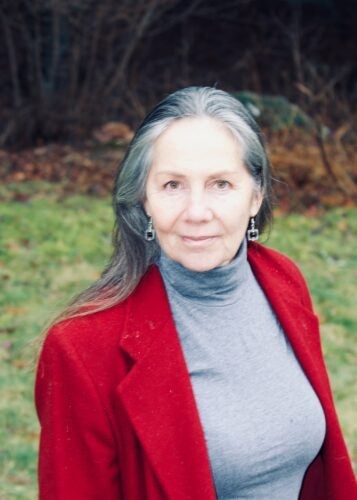By Sarah Heavren, CELS Communications Fellow

As an ecologist, Laura Meyerson has what she calls the greatest job in the world. Some days, she spends all day in the greenhouse, while other days she is in the lab. She does fieldwork in Rhode Island and all over the world, all while teaching courses about her passion and inspiring students to get involved with policy, advocacy, and research.
“I wake up in the morning,” Meyerson said, “walk outside my front door, and I look around at the beautiful trees and everything I have in my front yard, and I say, ‘Okay, how can I save the world today?’”
Much of Meyerson’s world-saving work as a professor in the Department of Natural Resources Science focuses on fighting invasive species—non-native organisms that can wreak havoc on the delicate ecological balance of their new environment.
Her first encounter with an invasive species came as a master’s student at Yale, when her professor led the class down a little path that led to a marsh, pointing out the native plants and muskrat habitat. Meyerson’s wonder and awe turned to concern as her professor explained how there was an “evil invasive species coming along that will destroy this ecosystem completely.” The invasive species, Phragmites australis, was the culprit. The reed grass is typically found in wetlands, where it chokes out the native species, Phragmites americanus, along many other native plants and species vital to ecosystems.
“I got so upset and angry and outraged that this invasive species was going to come in and ruin this gorgeous habitat where the muskrat lived,” Meyerson said. She’s been working to better understand that species and its interactions with ecosystems ever since.
Phragmites are a bit like the lab mouse of the field ecology world. They’re a model species that can be used in field ecology to study genetics, plant-insect interactions, and the effects of climate change. “It’s been a really handy model species,” Meyerson says, “to study many different aspects of ecology and invasions in science. For example, scientists can use phragmites to research how stressful environmental conditions from climate change alter plant chemistry and what effects these changes have on the insects and other herbivores that rely on those plants.”
However, plant-human interactions are also important. Either knowingly or unknowingly, humans can introduce invasive species to ecosystems through agriculture, horticulture, trade, and travel or transportation.“Biological invasions occur almost exclusively, but not entirely, due to people,” Meyerson said. “Invasive species can be very pretty or very charismatic. They can be very colorful or interesting, kind of exotic. Even though they have these traits that we like, they can be very damaging to the environment.” Invasive species can damage more than just an ecosystem. They ruin people’s livelihoods. People lose their way to live.”
As an environmental advocate, Meyerson wants to empower people to recognize that they can play a role in the invasive species crisis. “It’s a problem that we all as a society need to address and work together and think about and need to educate each other,” she said.
One of Meyerson’s most recent projects with invasive species involves the American chestnut tree, a species that was once iconic in the Eastern United States but was decimated by an invasive fungus in the early twentieth century. Her students have been working to establish a chestnut orchard at URI, and they are determining whether to plant purebred chestnuts or genetically modified trees produced at the State University of New York College of Environmental Science and Forestry. The genetically modified, or transgenic, trees, contain a gene from a species of wheat that makes them resistant to the deadly fungus. However, a genetically modified American chestnut tree is yet to be released into the wild (pending USDA approval), which poses a host of questions for restoration efforts.
“The restoration of the American chestnut is at a turning point,” Meyerson explains. “It’s a tough issue. It’s a real risk, releasing a transgenic organism into the environment versus letting the species go truly extinct.” Students have been involved in the project throughout its early stages. In addition to helping create the orchard, students have also attended a board meeting at Smith College with the Massachusetts/Rhode Island chapter of the American Chestnut Foundation, a non-profit that has been working on American chestnut restoration for the past four decades. Students have been wrestling with the political and ethical implications of planting genetically modified organisms, and there has been a mixture of passion and controversy in the class. “Regardless of how it ends up, it seems like it will be a great resource for not just my students in my classes but also faculty,” Meyerson comments about the orchard.
Meyerson’s drive has led her to have an accomplished career. She is currently working with a group of over forty scientists from across the globe on an international report on invasive species for the Intergovernmental Panel on Biodiversity and Ecosystem Services. In addition to receiving a number of prestigious fellowships and grants and being a two-time Fulbright Scholar, Meyerson has published more than 125 papers and is co-editor-in-chief of Biological Invasions, the leading journal in the field of invasion science.
But after all the accolades, Meyerson works to keep the focus on her passions: Working to preserve precious ecosystems and inspiring her students. “The most important thing to me is inspiring our students, inspiring them and giving them the confidence to go out there and be leaders and change the world,” she says.
